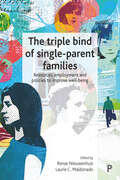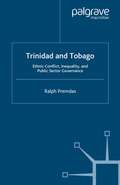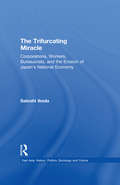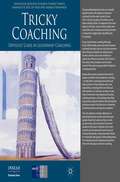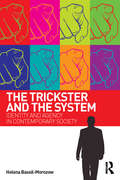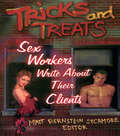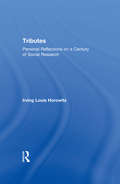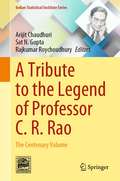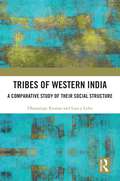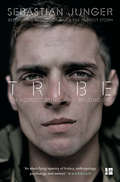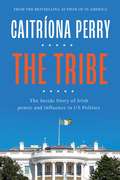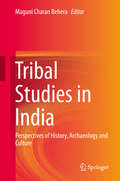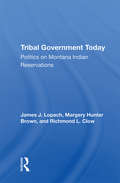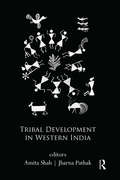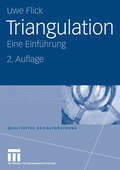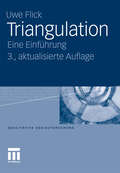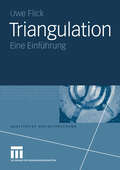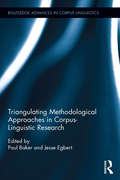- Table View
- List View
The triple bind of single-parent families: Resources, employment and policies to improve wellbeing
by Rense Nieuwenhuis Laurie C. MaldonadoAvailable Open Access under CC-BY-NC licence. Single parents face a triple bind of inadequate resources, employment, and policies, which in combination further complicate their lives. This book - multi-disciplinary and comparative in design - shows evidence from over 40 countries, along with detailed case studies of Sweden, Iceland, Scotland, and the UK. It covers aspects of well-being that include poverty, good quality jobs, the middle class, wealth, health, children’s development and performance in school, and reflects on social justice. Leading international scholars challenge our current understanding of what works and draw policy lessons on how to improve the well-being of single parents and their children.
Trinidad and Tobago: Ethnic Conflict, Inequality and Public Sector Governance (Ethnicity, Inequality and Public Sector Governance)
by Ralph PremdasHow does a multi-ethnic society resolve the contentious issue of resource allocation without damaging the state? This study examines inequality in terms of distributive justice, adaptation of political institutions, the role of symbols of recognition in representation and conflict management in power sharing, resource allocation and public policy.
The Trifurcating Miracle: Corporations, Workers, Bureaucrats, and the Erosion of Japan's National Economy (East Asia: History, Politics, Sociology and Culture)
by Satoshi IkedaThis title examines the transformation of Japan's national economy. It employs the concept of the structure of accumulation composed of the organizations of labor, credit and markets. The postwar Japanese miracle trifurcated into prosperous corportions, squeezed workers and parasitic bureaucracy in the slow growth period, 1974-91. The "miracle" continues only for the major Japanese corporations that are East Asianizing and globalizing.
The Trifurcating Miracle: Corporations, Workers, Bureaucrats, and the Erosion of Japan's National Economy (East Asia: History, Politics, Sociology and Culture)
by Satoshi IkedaThis title examines the transformation of Japan's national economy. It employs the concept of the structure of accumulation composed of the organizations of labor, credit and markets. The postwar Japanese miracle trifurcated into prosperous corportions, squeezed workers and parasitic bureaucracy in the slow growth period, 1974-91. The "miracle" continues only for the major Japanese corporations that are East Asianizing and globalizing.
Tricky Coaching: Difficult Cases in Leadership Coaching (INSEAD Business Press)
by Konstantin Korotov, Elizabeth Florent- Treacy, Manfred F. R. Kets de Vries and Andreas BernhardtBringing together cases written by experienced leadership and executive coaches from all over the world, this project explores the most demanding and challenging situations they have faced in their professional practices. By analysing and reflecting on the real life case studies the authors show how to deal with these situations in daily life.
The Trickster and the System: Identity and agency in contemporary society
by Helena Bassil-MorozowFor centuries, the trickster has been used in various narratives, including mythological, literary and cinematic, to convey the idea of agency, rebellion and, often turbulent, progress. In The Trickster and the System: Identity and Agency in Contemporary Society, Helena Bassil-Morozow shows how the trickster can be seen as a metaphor to describe the psycho-anthropological concept of change, an impulse that challenges the existing order of things, a progressive force that is a-structural and anti-structural in its nature. The book is about being able to see things from an unusual, even ‘odd’, perspective, which does not coincide with the homogenous normality of the mass, or the social system, or a political ideology, or some other kind of authority. The Trickster and the System offers an analytical paradigm which can be used to examine relationships between tricksters and systems, change and stability, in a wide range of social, political and cultural contexts. It covers a range of systems, describes different types of tricksters and discusses possible conflicts, tensions and dialogues between the two opposing sides. One of the central ideas of the book is that social systems use shame as a tool to control and manage all kinds of tricksters – individuality, agency, creativity, spontaneity, innovation and initiative, to name but a few. The author argues that any society that neglects its tricksters (agents of change), ends up suffering from decay, stagnation – or even mass hysterical outbursts. The Trickster and the System: Identity and Agency in Contemporary Society provides a fresh perspective on the trickster figure in a variety of cultural contexts. It covers a range of psychological, cultural, social and political phenomena, from personal issues to the highest level of society’s functioning: self-esteem and shame, lifestyle and relationships, creativity and self-expression, media, advertising, economy, political ideology and, most importantly, human identity and authenticity. The book is essential reading for scholars in the areas of psychoanalysis, analytical psychology, myth, cultural and media studies, narrative analysis, cultural anthropology, as well as anyone interested in critical issues in contemporary culture. Helena Bassil-Morozow is a cultural philosopher, film scholar and academic writer whose many publications include Tim Burton: The Monster and the Crowd (Routledge, 2010) and The Trickster in Contemporary Film (Routledge, 2011). Helena is currently working on another Routledge project, Jungian Film Studies: the Essential Guide (co-authored with Luke Hockley). Her principal academic affiliation is the University of Bedfordshire, Faculty of Creative Arts, Technologies & Science.
The Trickster and the System: Identity and agency in contemporary society
by Helena Bassil-MorozowFor centuries, the trickster has been used in various narratives, including mythological, literary and cinematic, to convey the idea of agency, rebellion and, often turbulent, progress. In The Trickster and the System: Identity and Agency in Contemporary Society, Helena Bassil-Morozow shows how the trickster can be seen as a metaphor to describe the psycho-anthropological concept of change, an impulse that challenges the existing order of things, a progressive force that is a-structural and anti-structural in its nature. The book is about being able to see things from an unusual, even ‘odd’, perspective, which does not coincide with the homogenous normality of the mass, or the social system, or a political ideology, or some other kind of authority. The Trickster and the System offers an analytical paradigm which can be used to examine relationships between tricksters and systems, change and stability, in a wide range of social, political and cultural contexts. It covers a range of systems, describes different types of tricksters and discusses possible conflicts, tensions and dialogues between the two opposing sides. One of the central ideas of the book is that social systems use shame as a tool to control and manage all kinds of tricksters – individuality, agency, creativity, spontaneity, innovation and initiative, to name but a few. The author argues that any society that neglects its tricksters (agents of change), ends up suffering from decay, stagnation – or even mass hysterical outbursts. The Trickster and the System: Identity and Agency in Contemporary Society provides a fresh perspective on the trickster figure in a variety of cultural contexts. It covers a range of psychological, cultural, social and political phenomena, from personal issues to the highest level of society’s functioning: self-esteem and shame, lifestyle and relationships, creativity and self-expression, media, advertising, economy, political ideology and, most importantly, human identity and authenticity. The book is essential reading for scholars in the areas of psychoanalysis, analytical psychology, myth, cultural and media studies, narrative analysis, cultural anthropology, as well as anyone interested in critical issues in contemporary culture. Helena Bassil-Morozow is a cultural philosopher, film scholar and academic writer whose many publications include Tim Burton: The Monster and the Crowd (Routledge, 2010) and The Trickster in Contemporary Film (Routledge, 2011). Helena is currently working on another Routledge project, Jungian Film Studies: the Essential Guide (co-authored with Luke Hockley). Her principal academic affiliation is the University of Bedfordshire, Faculty of Creative Arts, Technologies & Science.
Tricks and Treats: Sex Workers Write About Their Clients
by Matt Bernstein SycamoreLearn about the real lives of sex workers by exploring the sex industry from the inside!Explore the insightful--and oftentimes intense--accounts of sex workers who look squarely into the eyes of their clients, the sex industry, and society as a whole. Tricks and Treats delivers private stories about homo- and heterosexual encounters that sex workers usually confide only in each other. Not another “why I became a prostitute” book, it provocatively turns the tables on the buyers of sex, giving you a window into sex workers’lives. Tricks and Treats gives you straightforward accounts by sex workers to help you understand the pleasures, attractions, and truths of this profession. Tricks and Treats tantalizes with its powerful collection of tales from a diverse group of male, female, and transgendered sex workers. Their commercial, cultural, emotional, sexual, (il)legal, and even spiritual relationships with their clients are discussed in intimate detail. You will explore accounts from streetworkers, escorts, strippers, porn actors, masseurs, dominatrixes, phone sex operators, an adult-video store clerk, an outreach worker, a sex educator, and even a sperm donor.Tricks and Treats will ignite your imagination and answer questions few people dare to ask. You'll learn firsthand, of: how male, female, and transgendered hustlers turn tricks--in their own words--from sado-masochism and watersports to stripping, scat, foreplay, and fisting how sex workers face their own mortality when confronted with the AIDS virus a porn star's compassion and understanding for her fans a sex worker's coming-to-terms with his/her transgendered identity a male escort's attempts at dating a young man's experience of finding a family and home when living at a brothel a woman's story of spending thirty years as a prostitute the experiences of hooking on the streets and in clubs, cafes, and homesThese engaging and shocking testimonials will entertain you and offer a unique understanding of the sex industry. Revealing and intriguing, these poignant talks will certainly not disappoint your imagination. Tricks and Treats is a testament to the lives of sex workers, a manifestation of their spirit, and gives them a chance to turn the tables on their clients, exposing their erotic tastes, turn-ons, and fantasies.
Tricks and Treats: Sex Workers Write About Their Clients
by Matt Bernstein SycamoreLearn about the real lives of sex workers by exploring the sex industry from the inside!Explore the insightful--and oftentimes intense--accounts of sex workers who look squarely into the eyes of their clients, the sex industry, and society as a whole. Tricks and Treats delivers private stories about homo- and heterosexual encounters that sex workers usually confide only in each other. Not another “why I became a prostitute” book, it provocatively turns the tables on the buyers of sex, giving you a window into sex workers’lives. Tricks and Treats gives you straightforward accounts by sex workers to help you understand the pleasures, attractions, and truths of this profession. Tricks and Treats tantalizes with its powerful collection of tales from a diverse group of male, female, and transgendered sex workers. Their commercial, cultural, emotional, sexual, (il)legal, and even spiritual relationships with their clients are discussed in intimate detail. You will explore accounts from streetworkers, escorts, strippers, porn actors, masseurs, dominatrixes, phone sex operators, an adult-video store clerk, an outreach worker, a sex educator, and even a sperm donor.Tricks and Treats will ignite your imagination and answer questions few people dare to ask. You'll learn firsthand, of: how male, female, and transgendered hustlers turn tricks--in their own words--from sado-masochism and watersports to stripping, scat, foreplay, and fisting how sex workers face their own mortality when confronted with the AIDS virus a porn star's compassion and understanding for her fans a sex worker's coming-to-terms with his/her transgendered identity a male escort's attempts at dating a young man's experience of finding a family and home when living at a brothel a woman's story of spending thirty years as a prostitute the experiences of hooking on the streets and in clubs, cafes, and homesThese engaging and shocking testimonials will entertain you and offer a unique understanding of the sex industry. Revealing and intriguing, these poignant talks will certainly not disappoint your imagination. Tricks and Treats is a testament to the lives of sex workers, a manifestation of their spirit, and gives them a chance to turn the tables on their clients, exposing their erotic tastes, turn-ons, and fantasies.
Tributes: Personal Reflections on a Century of Social Research
by Irving HorowitzIn one of his final works, Stephen Jay Gould spoke of the human race "as a wildly improbable evolutionary event well within the realm of contingency." Drawing on his personal knowledge of fifty figures from the world of twentieth-century social science, Irving Louis Horowitz offers commentaries drawn from a variety of public occasions to explain one segment of this improbable event. In the process he reveals how the past century was defined in substantial measure by the rise of social research.Commenting on Tributes, Daniel Mahoney observes, "some pieces are completely authoritative and detailed, others more conversational and informal. That diversity of approaches tied to the special character of these people increases the readability and interest in the book as a whole. In addition to illuminating the life and thought of these major figures, these essays and addresses reveal the impressive catholicity of Horowitz's concerns and his ability to remain open to the widest range of theoretical and practical approaches." In a certain sense, this book is also an intellectual autobiography in the form of an expression of Horowitz's debt to intellectual interlocutors and influences over the years. As a consequence, Tributes will be of the greatest interest to anyone who wishes to come to terms with the intellectual formation of the people who gave substance to new ways of experiencing as well as explaining society. The book is thus a thoughtful guide to the intellectual life of our times.From Arendt and Aron to Veblen and Wildavsky, these essays take shape as a systematic mosaic of the past century. Written by a central participant in social theory, Tributes is both an informal guide and a formal text for readers coming upon social science innovators for the first time. The book breaks the boundaries of conventional discourse and in so doing gives voice to the outstanding figures that helped make the twentieth century "the century of social research."
Tributes: Personal Reflections on a Century of Social Research
by Irving HorowitzIn one of his final works, Stephen Jay Gould spoke of the human race "as a wildly improbable evolutionary event well within the realm of contingency." Drawing on his personal knowledge of fifty figures from the world of twentieth-century social science, Irving Louis Horowitz offers commentaries drawn from a variety of public occasions to explain one segment of this improbable event. In the process he reveals how the past century was defined in substantial measure by the rise of social research.Commenting on Tributes, Daniel Mahoney observes, "some pieces are completely authoritative and detailed, others more conversational and informal. That diversity of approaches tied to the special character of these people increases the readability and interest in the book as a whole. In addition to illuminating the life and thought of these major figures, these essays and addresses reveal the impressive catholicity of Horowitz's concerns and his ability to remain open to the widest range of theoretical and practical approaches." In a certain sense, this book is also an intellectual autobiography in the form of an expression of Horowitz's debt to intellectual interlocutors and influences over the years. As a consequence, Tributes will be of the greatest interest to anyone who wishes to come to terms with the intellectual formation of the people who gave substance to new ways of experiencing as well as explaining society. The book is thus a thoughtful guide to the intellectual life of our times.From Arendt and Aron to Veblen and Wildavsky, these essays take shape as a systematic mosaic of the past century. Written by a central participant in social theory, Tributes is both an informal guide and a formal text for readers coming upon social science innovators for the first time. The book breaks the boundaries of conventional discourse and in so doing gives voice to the outstanding figures that helped make the twentieth century "the century of social research."
A Tribute to the Legend of Professor C. R. Rao: The Centenary Volume (Indian Statistical Institute Series)
by Arijit Chaudhuri Sat N. Gupta Rajkumar RoychoudhuryThis book includes speeches given during five seminar sessions held in honor of Prof. C. R. Rao, on his 100th year. This book also contains a few write-ups touching on the diverse aspects of this august personality. The chapters pay tribute to Prof. C. R. Rao, the Padma Vibhushan awardee, by discussing his life and contributions to the field of statistics. The book also includes a chapter by the Abel Prize winner Prof. S. R. Varadhan who happened to successfully complete his Ph.D. under the guidance of Prof. C. R. Rao.
Tribes of Western India: A Comparative Study of Their Social Structure
by Dhananjay Kumar Lancy LoboIndia has two key social formations, the castes and the tribes. Both groups can be studied from the perspective of society (samaj) and culture (sanskriti). However, studies on castes largely deal with social structure and less on culture, while studies on tribes focus more on culture than on social structure. What has resulted from this bias is a general misunderstanding that tribes have a rich culture, but lack social structure. This volume emerges out of an in-depth empirical study of the social structure of five Scheduled Tribes (STs) in Gujarat, Western India, viz., Gamit, Vasava, Chaudhari, Kukana, and Warli. It analyses and compares their internal social organization consisting of institutions of household, family, lineage, clan, kinship rules and marriage networks. The book also deals with changes taking place in the social structure of contemporary tribal societies. While the focus is mainly on the data from tribes of Western India, the issues are relevant to pan Indian tribes. An important contribution to the studies on tribes of India, this book will be of great interest to students and researchers of anthropology, sociology, demography, history, tribal studies, social work, public policy, and law. It will also be of interest to professionals working with NGOs and civil society, programme and policy formulating authorities, and bureaucrats.
Tribes of Western India: A Comparative Study of Their Social Structure
by Dhananjay Kumar Lancy LoboIndia has two key social formations, the castes and the tribes. Both groups can be studied from the perspective of society (samaj) and culture (sanskriti). However, studies on castes largely deal with social structure and less on culture, while studies on tribes focus more on culture than on social structure. What has resulted from this bias is a general misunderstanding that tribes have a rich culture, but lack social structure. This volume emerges out of an in-depth empirical study of the social structure of five Scheduled Tribes (STs) in Gujarat, Western India, viz., Gamit, Vasava, Chaudhari, Kukana, and Warli. It analyses and compares their internal social organization consisting of institutions of household, family, lineage, clan, kinship rules and marriage networks. The book also deals with changes taking place in the social structure of contemporary tribal societies. While the focus is mainly on the data from tribes of Western India, the issues are relevant to pan Indian tribes. An important contribution to the studies on tribes of India, this book will be of great interest to students and researchers of anthropology, sociology, demography, history, tribal studies, social work, public policy, and law. It will also be of interest to professionals working with NGOs and civil society, programme and policy formulating authorities, and bureaucrats.
Tribe: On Homecoming And Belonging
by Sebastian JungerFrom the author of THE PERFECT STORM and WAR comes a book about why men miss war, why Londoners missed the Blitz, and what we can all learn from American Indian captives who refused to go home.
The Tribe: The Inside Story of Irish Power and Influence in US Politics
by Caitríona PerryIn The Tribe, Caitríona Perry is on familiar ground, returning to Washington and the green strongholds of the United States.Irish Americans were once considered kingmakers in local and national elections, but generations of assimilation and rising numbers of newer immigrants have diluted that power. Many even argue that the concept of an Irish vote is dead.But through exclusive interviews with powerful Irish American insiders, including President Bill Clinton, President Donald Trump’s former Press Secretary Sean Spicer, Trump’s Chief of Staff Mick Mulvaney, Congressman Joe Kennedy III, legendary Boston mayor Ray Flynn and many more, a clear sense that the Irish are still wielding valuable soft power at the highest levels of US politics emerges.Here, Caitríona Perry gets to the heart of the source and effectiveness of Irish power and influence in America and how it could, or should, evolve in a post-Brexit world, offering a fascinating insight into the inner workings of US politics.Perspectives on Irish America from some of the interviewees in The Tribe‘I knew getting involved in Northern Ireland was a controversial thing to do, but I knew that America had an unusual impact or potential impact on the situation. I just thought we had the largest Irish diaspora in the world, and we ought to get involved.’ Former US President Bill Clinton‘Often times we work on Irish issues together across the aisle because of the cultural connection. Is that a voting bloc? No. Does that mean the Irish punch way above their weight? Yes, it absolutely does.’ Chief of Staff to President Trump, Mick Mulvaney‘The thing that is truly unique in America is that there is not another country that gets the attention that Ireland does. So our entire country stops and celebrates St Patrick’s Day in a way that we don’t celebrate any other culture or country.’ Former White House Press Secretary Sean Spicer‘The commitment that our countries have made to each other, regardless of party, regardless of who’s in power back in Ireland or here at home, is something to be nurtured and respected and it would be a shame for anybody to do any damage to that.’ Democratic Congressman Joe Kennedy III‘The relationship between Ireland and the US is not a political tie. It’s a tie at a cellular level.’ Kevin O’Malley, former US Ambassador to Ireland
Tribal Studies in India: Perspectives of History, Archaeology and Culture
by Maguni Charan BeheraThis book provides comprehensive information on enlargement of methodological and empirical choices in a multidisciplinary perspective by breaking down the monopoly of possessing tribal studies in the confinement of conventional disciplinary boundaries. Focusing on anyone of the core themes of history, archaeology or anthropology, the chapters are suggestive of grand theories of tribal interaction over time and space within a frame of composite understanding of human civilization. With distinct cross-disciplinary analytical frames, the chapters maximize reader insights into the emerging trend of perspective shifts in tribal studies, thus mapping multi-dimensional growth of knowledge in the field and providing a road-map of empirical and theoretical understanding of tribal issues in contemporary academics. This book will be useful for researchers and scholars of anthropology, ethnohistory ethnoarchaeology and of allied subjects like sociology, social work, geography who are interested in tribal studies. Finally, the book can also prove useful to policy makers to better understand the historical context of tribal societies for whom new policies are being created and implemented.
Tribal Government Today: Politics On Montana Indian Reservations
by James J LopachThere has been surprisingly little writing about the condition of contemporary tribal government. Library shelves are filled with works on other American and foreign governments, but an inquirer must leam about tribal government incidentally and in piecemeal fashion. This state of scholarship is regrettable because of the importance of the modem I
Tribal Government Today: Politics On Montana Indian Reservations
by James J LopachThere has been surprisingly little writing about the condition of contemporary tribal government. Library shelves are filled with works on other American and foreign governments, but an inquirer must leam about tribal government incidentally and in piecemeal fashion. This state of scholarship is regrettable because of the importance of the modem I
Tribal Development in Western India
by Amita Shah Jharna PathakTribal communities in western India, as elsewhere in the country, have been facing increasing marginalisation and poverty. This is so despite a relatively better record of social movements and work by civil society organisations among them and their political inclusion. Further, the existing literature on tribals focuses more on their socio-cultural situation and less on their economic and human development. Addressing this gap in scholarship, this volume details the processes of tribal development and associated challenges in Gujarat, often viewed as a high-growth economy. Rich in interdisciplinary, empirical analyses, the book comprehensively addresses three important aspects of tribal development — human development, economic opportunities and governance. It critiques recent policy diagnoses and interventions, rather than evaluate policy-outcomes. The volume traces the genesis of continued marginalisation of tribals in the country, and contributes to the ongoing discourse on integrative tribal development. The work will interest scholars and students of development studies, tribal studies, economics, sociology, social work, as also policy-makers, activists, and governmental and non-governmental organisations in the field.
Tribal Development in Western India
by Amita Shah Jharna PathakTribal communities in western India, as elsewhere in the country, have been facing increasing marginalisation and poverty. This is so despite a relatively better record of social movements and work by civil society organisations among them and their political inclusion. Further, the existing literature on tribals focuses more on their socio-cultural situation and less on their economic and human development. Addressing this gap in scholarship, this volume details the processes of tribal development and associated challenges in Gujarat, often viewed as a high-growth economy. Rich in interdisciplinary, empirical analyses, the book comprehensively addresses three important aspects of tribal development — human development, economic opportunities and governance. It critiques recent policy diagnoses and interventions, rather than evaluate policy-outcomes. The volume traces the genesis of continued marginalisation of tribals in the country, and contributes to the ongoing discourse on integrative tribal development. The work will interest scholars and students of development studies, tribal studies, economics, sociology, social work, as also policy-makers, activists, and governmental and non-governmental organisations in the field.
Triangulation: Eine Einführung (Qualitative Sozialforschung)
by Uwe FlickDas Buch führt anhand konkreter Vorgehensweisen in die Diskussion und Praxis der Triangulation ein. Es zeichnet Ursprung und Geschichte des Konzepts sowie kritische Diskussionen nach. Triangulation sollte sich nicht in der reinen Verbindung von Methoden erschöpfen. Erst in der Verknüpfung deren theoretischer Hintergründe entfaltet sie ihr Potential. An praktischen Beispielen wird die Triangulation verschiedener qualitativer und von qualitativen mit quantitativen Methoden dargestellt. Ausgewählte Studien mit diesen Formen werden vorgestellt, um die Beurteilung des Nutzens und des Aufwandes von Triangulation zu erleichtern. Praktische Durchführungsprobleme von Triangulationsstudien werden als Leitfaden für Studierende behandelt. Die Bedeutung von Triangulation als Kriterium qualitativer Forschung, in der Verallgemeinerung und als Mittel der Erkenntnis wird an ihrer Verwendung in den unterschiedlichen Schritten des Forschungsprozesses verdeutlicht.
Triangulation: Eine Einführung (Qualitative Sozialforschung)
by Uwe FlickDas Buch führt anhand konkreter Vorgehensweisen in die Diskussion und Praxis der Triangulation ein. Es zeichnet Ursprung und Geschichte des Konzepts sowie kritische Diskussionen nach. Triangulation sollte sich nicht in der reinen Verbindung von Methoden erschöpfen. Erst in der Verknüpfung deren theoretischer Hintergründe entfaltet sie ihr Potential. An praktischen Beispielen wird die Triangulation verschiedener qualitativer und von qualitativen mit quantitativen Methoden dargestellt. Ausgewählte Studien mit diesen Formen werden vorgestellt, um die Beurteilung des Nutzens und des Aufwandes von Triangulation zu erleichtern.
Triangulation: Eine Einführung (Qualitative Sozialforschung #12)
by Uwe FlickDas Buch führt anhand konkreter Vorgehensweisen in die Diskussion und Praxis der Triangulation ein. Es zeichnet Ursprung und Geschichte des Konzepts sowie kritische Diskussionen nach. Triangulation sollte sich nicht in der reinen Verbindung von Methoden erschöpfen. Erst in der Verknüpfung deren theoretischer Hintergründe entfaltet sie ihr Potential. An praktischen Beispielen wird die Triangulation verschiedener qualitativer und von qualitativen mit quantitativen Methoden dargestellt. Ausgewählte Studien mit diesen Formen werden vorgestellt, um die Beurteilung des Nutzens und des Aufwandes von Triangulation zu erleichtern. Praktische Durchführungsprobleme von Triangulationsstudien werden als Leitfaden für Studierende behandelt. Die Bedeutung von Triangulation als Kriterium qualitativer Forschung, in der Verallgemeinerung und als Mittel der Erkenntnis wird an ihrer Verwendung in den unterschiedlichen Schritten des Forschungsprozesses verdeutlicht.
Triangulating Methodological Approaches in Corpus Linguistic Research (Routledge Advances in Corpus Linguistics)
by Paul Baker Jesse EgbertContemporary corpus linguists use a wide variety of methods to study discourse patterns. This volume provides a systematic comparison of various methodological approaches in corpus linguistics through a series of parallel empirical studies that use a single corpus dataset to answer the same overarching research question. Ten contributing experts each use a different method to address the same broadly framed research question: In what ways does language use in online Q+A forum responses differ across four world English varieties (India, Philippines, United Kingdom, and United States)? Contributions will be based on analysis of the same 400,000 word corpus from online Q+A forums, and contributors employ methodologies including corpus-based discourse analysis, audience perceptions, Multi-Dimensional analysis, pragmatic analysis, and keyword analysis. In their introductory and concluding chapters, the volume editors compare and contrast the findings from each method and assess the degree to which ‘triangulating’ multiple approaches may provide a more nuanced understanding of a research question, with the aim of identifying a set of complementary approaches which could arguably take into account analytical blind spots. Baker and Egbert also consider the importance of issues such as researcher subjectivity, type of annotation, the limitations and affordances of different corpus tools, the relative strengths of qualitative and quantitative approaches, and the value of considering data or information beyond the corpus. Rather than attempting to find the ‘best’ approach, the focus of the volume is on how different corpus linguistic methodologies may complement one another, and raises suggestions for further methodological studies which use triangulation to enrich corpus-related research.
